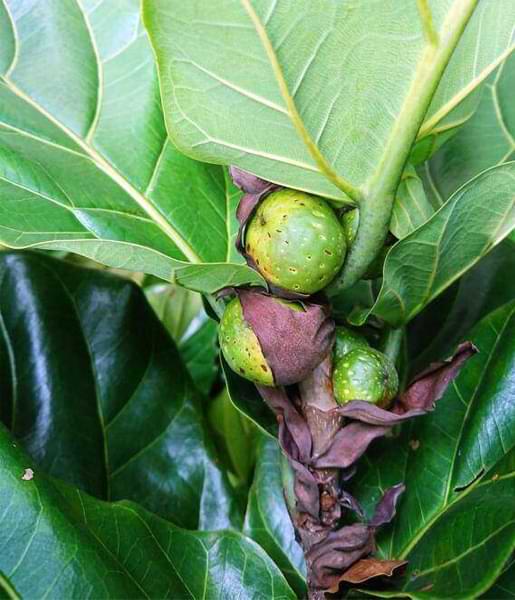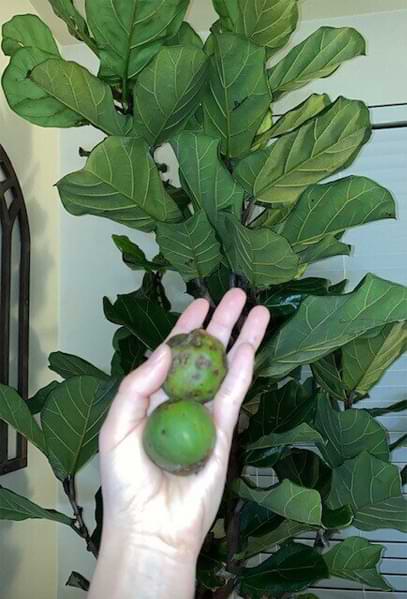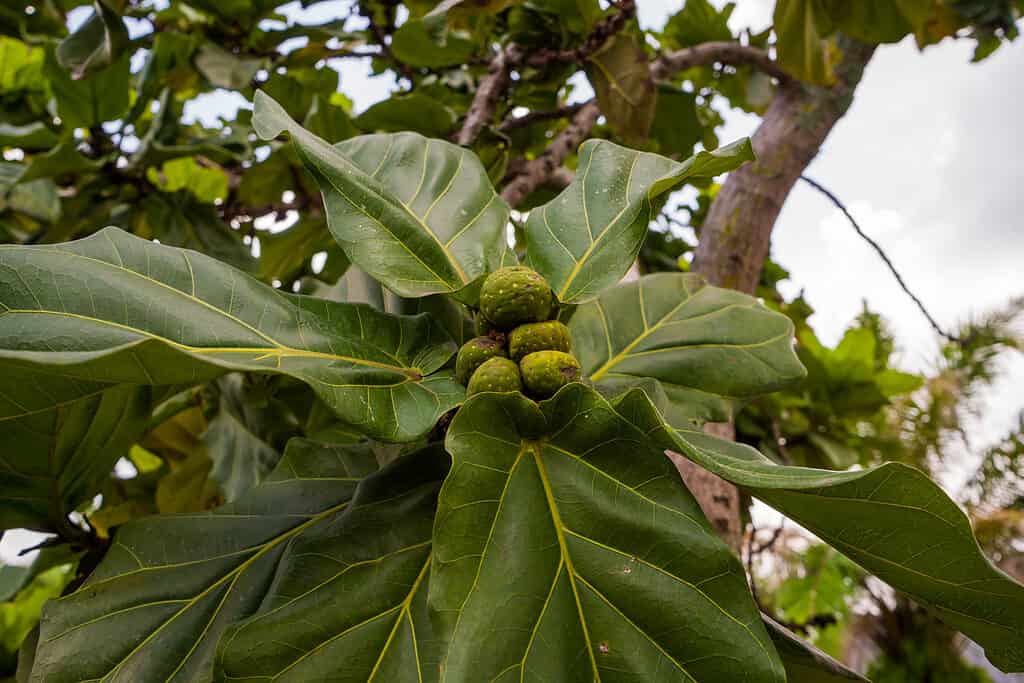The fiddle leaf fig (Ficus lyrata) is one of the most popular houseplants, prized for its large, violin-shaped leaves. But despite having “fig” in its name, these trees rarely produce any fruit when grown indoors. This leaves many plant owners wondering—does a fiddle leaf fig actually produce figs?
As it turns out, fiddle leaf figs can and do bear fruit when grown in the right conditions. However, there are several reasons why indoor fiddle leaf figs typically do not yield any figs Let’s take a closer look at how these unique plants reproduce and the fascinating relationship between figs and wasps that makes it all possible
Why Fiddle Leaf Figs Are Called “Figs”
Fiddle leaf figs belong to the Ficus genus which contains over 800 species of woody trees shrubs, and vines. Many Ficus species do produce edible fruits, such as
- Common fig (Ficus carica) – produces the sweet figs we eat
- Strangler fig (Ficus aurea) – bears small, berry-like figs
- Rubber plant (Ficus elastica) – can produce petite, purple figs
So the fiddle leaf fig is called a “fig” because of its relation to other edible fig species. However, the fruits of Ficus lyrata are not considered palatable, especially when compared to other tastier fig varieties.
Do Fiddle Leaf Figs Produce Fruit Outdoors?
When grown outdoors in ideal conditions, fiddle leaf fig trees can and do bear fruit. However, this occurs very rarely indoors due to some key factors:
Light Requirements
Fiddle leaf figs require a lot of bright, indirect light to thrive. But they need even more light if they are to put energy towards producing flowers and fruit. Most homes simply don’t provide enough light.
Lack of Pollinators
Figs have a unique pollination process that relies on fig wasps. Since these specialized wasps don’t exist indoors, indoor fiddle leaf figs lack a pollinator to trigger fruit production.
Age of Plant
Fiddle leaf figs can take 3-5 years to reach maturity. Only mature plants will produce flowers and fruit. Most indoor plants are relatively young.
Growing Conditions
The warm, humid conditions of the fiddle leaf fig’s native tropical habitat encourage flowering and fruiting. Most homes can’t mimic these ideal conditions.
The Relationship Between Figs and Wasps
Here is a quick overview of the coevolved relationship between figs and fig wasps that allows fruit production:
-
Male and female flowers grow inside an immature fig fruit.
-
To reproduce, the flowers must be pollinated by a female fig wasp.
-
The wasp enters the fig and lays her eggs inside the cavity while pollinating the flowers.
-
The eggs hatch and new wasps develop inside the fig.
-
Male wasps then chew tunnels and escape, dying after mating with females.
-
Females escape, carrying pollen to new figs, and the cycle repeats.
So in essence, no wasps means no pollination, and no pollination means no viable seeds and no ripe fig fruits.
What Do Fiddle Leaf Fig Fruits Look Like?
When grown outside in tropical conditions, fiddle leaf figs can produce smooth, rounded fruits around 3⁄4” to 1” wide. The exterior is green when unripe, ripening to a brownish-purple.
Inside, the flesh is not sweet and juicy like commercial figs. It is instead rather dry and slightly tangy or sour. The fruits are not considered tasty, which is why fiddle leaf figs are not cultivated for their fruits.
Can You Eat Fiddle Leaf Fig Fruits?
While fiddle leaf fig fruits are not poisonous, they are generally considered inedible for humans due to their unappealing flavor and texture. The fruits are sometimes used to feed livestock, but otherwise provide no culinary value.
If your outdoor fiddle leaf fig does produce figs, there is no need to harvest them. You can simply compost the fruits to provide nutrients to other plants in your garden.
Should You Pick Fiddle Leaf Fig Fruits?
Most experts recommend leaving any figs that form on your outdoor fiddle leaf fig. Picking the fruits deprives the plant of the energy used to create the figs in the first place.
Plus, allowing figs to remain on the plant can help attract pollinators for future fruit production. However, pruning away any developing figs on an indoor plant prevents the plant from wasting energy on fruits that won’t fully develop anyways in the absence of wasps.
Can You Grow a Fiddle Leaf Fig from Seed?
Because fiddle leaf fig seeds require the specialized fig wasp pollinators, the plants cannot come true from seed. Propagating fiddle leaf figs is only possible through stem cuttings. Growing them from seeds is essentially impossible for home gardeners.
The Takeaway
While fiddle leaf figs can produce edible fruits in the wild, this rarely occurs with indoor plants. Lack of light, pollinators, humidity, and other factors prevent most indoor fiddle leaf figs from ever bearing viable flowers and fruits. But this does not diminish their value as attractive houseplants with gorgeous leaves. So feel proud if your outdoor fiddle leaf fig manages the tricky task of producing figs, but don’t expect fruit from your indoor specimens.
How Fiddle Leaf Fruit Figs Develop
Figs are one of the most fascinating fruits because of the way they grow. And it all starts with a wasp.
Figs have a unique, crunchy texture. This is because the inside of the structure is made up of flowers and seeds that grow into figs.
These clusters of inside-out flowers act as the ovaries of the fig tree. In order to reproduce, these flowers must be pollinated by a fig wasp.
When the fruits start to get ripe, a female fig wasp will go into them through a small hole, lay her eggs, and pollinate the flower at the same time. The female wasp then injects a chemical into the flower that makes it ripen so that her young can eat it. This will cause the flower to ripen into what we typically consider a fruit.

The female wasp then dies and her eggs hatch. The baby wasps will grow up and mate with each other inside the fruit. The male wasps will chew holes in the fruit and then die, letting the females, who are now pregnant, leave the fig. Once the females get out of the ripe fruit, they will find their own fig fruits to lay their eggs in. Then, they will use pollen from the fruit where they were born to fertilize those fruits, and the cycle starts all over again.
Interesting, gruesome, and fascinating, right?

Ficus carica is the common fig tree that gives us the fruit we eat the most. It has both male and female flowers, so pollen from other fruits on the same tree can reach the female fruits and make them fertile. These figs are considered monoecious and produce edible (or at least palatable) fruit.
Other fig-trees, ficus lyrata included, are considered dioecious and grow fruit that is both male and female. More than one tree is necessary for fruit production (another reason why fiddles almost never fruit indoors!).
These dioecious trees tend to produce fruit that just doesn’t taste good. This fruit is sometimes used for animal feed but otherwise is thrown away. Photo Credit: Forest & Kim Starr (Click for Link).
These wasps have short life cycles of just two months, which allows ficus trees to produce fruit year-round. If you have an outdoor fiddle leaf fig tree that gets enough sun and has pollinators, you might get fruit at any time of the year!
Why don’t indoor fiddle leaf figs bear fruit?
Part of the reason why indoor fiddles almost never fruit is light conditions. Fiddles require a lot of light just to be healthy, and even more to actually fruit.
Another, even more important reason is that there aren’t many pollinators inside, and ficus species need pollinators, especially wasps, to grow figs. And it’s not as easy as a wasp flying from flower to flower in a sunny field to pollinate figs. It is a much more interesting and sad story of coevolution, which means that two species have become so dependent on each other that they can’t live or reproduce without each other.
This is why it is nearly impossible to grow a fiddle leaf fig from a seed.
My Fiddle Leaf Fig now has fruits!
FAQ
Is fiddle leaf fig fruit edible?
Will an indoor fig tree produce fruit?
What is the difference between a fiddle leaf fig and a fig tree?
What are the benefits of a fiddle leaf fig tree?
Do fiddle leaf fig trees bear fruit?
As fiddle leaf fig owners, we’re big fans of those beautiful, iconically fiddle-shaped leaves, but we often forget that ficus lyrata is also a variety of fig tree. So sometimes, our fiddles will actually bear fruit! Now, indoor trees (which is what most of us own) rarely fruit.
Do fiddles produce figs?
Fun fact: Fiddles are a type of fig tree, so they actually can produce a fig-like fruit! But these definitely are NOT the figs you find in Newtons or in the produce section in late summer. These fruits are bland and seedy, and indoor fiddles rarely fruit.
Are fiddle leaf figs edible?
While they share the same genus as the delicious fruit–bearing common fig, Ficus carica, fiddle leaf figs won’t fruit when grown indoors. They may bear fruit when grown as an outdoor plant, but it is not edible . F. lyrata is native to the tropical central and southern portions of Africa, where it can grow to sizes of more than 30 feet tall.
Do fiddle leaf fig trees grow indoors?
They will thrive in an area with bright, filtered light or an eastern facing window. Careful watering and warmer temperatures will help fiddle leaf fig thrive. Contrary to its name, the indoor fiddle leaf fig tree produces no fruit. Tall, sculptural, and dramatic. This plant will flourish in the right conditions.
- The Ultimate Guide to Growing Strawberries in Raised Beds - August 8, 2025
- No-Dig Garden Beds: The Easiest Way to Grow a Beautiful Garden - August 6, 2025
- How to Protect and Preserve Wood for Raised Garden Beds - August 6, 2025

